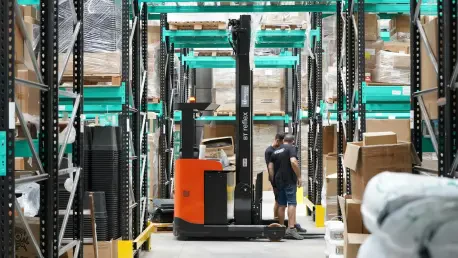In an era where global supply chains face unprecedented pressure to deliver faster and more efficiently, a groundbreaking partnership has emerged to redefine warehouse operations through cutting-edge technology. GreyOrange, a prominent name in warehouse orchestration software and hardware, has joined forces with Google Cloud to introduce an AI-driven solution that promises to revolutionize autonomous robotic systems. Known as GreyMatter DeepNav, this innovation harnesses advanced artificial intelligence to tackle persistent challenges in automation, such as slow deployment and limited scalability. Set to launch in early 2026, the solution aims to transform how warehouses function in retail, logistics, and supply chain sectors worldwide. By leveraging Google Cloud’s powerful tools, this collaboration signals a shift toward smarter, more adaptive systems that could set a new standard for operational excellence in high-demand environments.
Harnessing AI for Next-Level Automation
The core of this partnership lies in the integration of artificial intelligence to enhance the capabilities of Autonomous Mobile Robots (AMRs) in warehouse settings. GreyMatter DeepNav builds on GreyOrange’s established multi-agent orchestration platform, combining it with Google Cloud’s Vertex AI to deliver unparalleled efficiency. Unlike traditional systems that depend heavily on manually programmed rules and minimal machine learning, this solution employs reinforcement learning to drastically cut down the time needed for training robots. Where conventional methods might take months to adapt to new layouts or tasks, this technology enables AMRs to optimize navigation and execution in just weeks. Such rapid adaptability is crucial in dynamic, high-density environments where change is constant, ensuring that operations remain seamless even as demands evolve.
Beyond speed, the focus on intelligent automation addresses a critical industry pain point: the inability to scale robotic fleets effectively. GreyMatter DeepNav is engineered to manage thousands of robots simultaneously, far surpassing the typical industry limit of a few hundred units. This scalability is paired with real-time decision-making capabilities, allowing robots to navigate complex, ever-changing warehouse layouts with precision. Features like dynamic task assignment and adherence to strict Service Level Agreements (SLAs) further enhance operational reliability. This leap in technology not only boosts efficiency but also reduces the need for costly human intervention, marking a significant step toward fully autonomous warehouse ecosystems that can keep pace with modern supply chain demands.
Transforming Warehouses into Living Ecosystems
Industry leaders view this collaboration as a transformative moment for warehouse management, envisioning facilities as interconnected, intelligent systems rather than static spaces. Akash Gupta, co-founder and CEO of GreyOrange, describes the warehouse as a “living ecosystem,” where GreyMatter DeepNav integrates hardware, people, and processes through real-time AI orchestration. Trained on billions of real-world actions, the platform enables rapid innovation without the prolonged wait for returns on investment. This perspective highlights how the solution empowers businesses to adapt swiftly to market changes, ensuring that technology serves as a catalyst for growth rather than a bottleneck in operational workflows.
Complementing this vision, Paula Natoli, global director of supply chain and logistics strategy at Google Cloud, emphasizes the role of Vertex AI in shaping the future of warehouse operations. By providing robust machine learning tools, the platform accelerates the deployment of AMRs and supports scaling to unprecedented levels. This synergy between advanced AI and practical application is poised to turn complex data into actionable insights, driving operational excellence across global supply chains. The shared belief among stakeholders is that such advancements are not just incremental but represent a fundamental reimagining of how warehouses can operate, prioritizing adaptability and intelligence in every aspect of automation.
Redefining Industry Standards with Scalable Solutions
One of the standout achievements of GreyMatter DeepNav is its capacity to handle up to 1 million AMR operations per minute, a benchmark that underscores the trend toward data-driven automation. This capability offers deeper insights into robotic behavior under real-world conditions, enhancing both safety and efficiency in high-stakes environments. For original equipment manufacturers (OEMs) and integrators, access to such detailed data transforms path planning and deployment strategies, enabling more informed decision-making. As supply chains grow increasingly complex, this level of precision ensures that automation keeps pace with demand, setting a new bar for what is possible in large-scale operations.
Moreover, this development reflects a broader shift away from rigid, labor-intensive systems toward flexible, AI-powered solutions that can evolve with industry needs. The ability to manage vast robotic fleets in both structured and unstructured settings addresses long-standing barriers to adoption, making automation accessible to a wider range of businesses. By condensing deployment timelines and enhancing scalability, GreyMatter DeepNav not only solves immediate operational challenges but also paves the way for future innovations. This partnership stands as a testament to the potential of collaborative technology to reshape logistics, ensuring that warehouses are equipped to meet the challenges of a fast-paced, interconnected world.
Pioneering the Future of Supply Chain Efficiency
Looking back, the collaboration between GreyOrange and Google Cloud to launch GreyMatter DeepNav marked a pivotal moment in the evolution of warehouse automation. Unveiled as a solution to longstanding inefficiencies, it redefined how AMRs could be deployed and scaled with AI-driven precision. The partnership demonstrated a clear path to operational excellence, offering tools that transformed complex data into real-time results. As businesses reflected on this milestone, the focus shifted to actionable next steps, such as integrating these technologies into diverse operational frameworks and exploring further AI applications. With the solution’s rollout in early 2026 on the horizon, stakeholders anticipated a ripple effect across the industry, encouraging continuous investment in smart automation to build resilient, future-ready supply chains.









